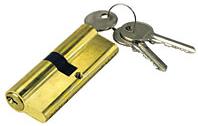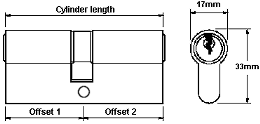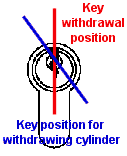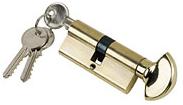Replacing a Euro lock cylinder
removing/refitting a euro cylinder - purchasing a new cylinder
Euro cylinder locks are widely used in modern doors including uPVC, double glazed doors, patio doors and other modern doors. The locks consist of two parts:
- The basic body with the bolt, catch etc which fits into the door and door jamb (below left)
and - The cylinder which contains the lock part (below right) - where there is a key at both ends, both keys cannot be used at the same time.
 A typical basic body |
 A cylinder for a Euro lock |
Replacing the cylinder of a euro lock may be necessary if a set of keys has been lost or you move into a new property and want to be confident that there are no keys unaccounted for. Or you may want to change the style of lock to one with an internal 'thumb turn' knob - this is ideal where you do not want to be locked out of a room (such as a child's or old person's room. Alternatively you may want to change from a 'thumb turn' lock to a double key style - probably advisable for a front door where there are children in the household.
Removing/refitting Euro cylinder
 Although the section
of euro cylinders are standard, the length of the cylinder and the offsets each side of the fixing screw hole do vary, so the original lock will first need to be removed from the door so that these can be measured on the cylinder. .
Although the section
of euro cylinders are standard, the length of the cylinder and the offsets each side of the fixing screw hole do vary, so the original lock will first need to be removed from the door so that these can be measured on the cylinder. .
- Unlock and open the door.
- Locate on the edge of the door the screw securing the cylinder, (usually this will be a large headed screw in line with the lower end of the cylinder) - remove this screw.
 Next insert the key in the lock and turn it so that the cam lines up with the body of the cylinder which will allow it to be withdrawn - the cam is not visible so this has to be done by feel - normally the position of the key needs to be about 25° off of the unlocked key removal position. The illustration to the right indicates the approximate position; however, it may be clockwise rather than anticlockwise as shown.
Next insert the key in the lock and turn it so that the cam lines up with the body of the cylinder which will allow it to be withdrawn - the cam is not visible so this has to be done by feel - normally the position of the key needs to be about 25° off of the unlocked key removal position. The illustration to the right indicates the approximate position; however, it may be clockwise rather than anticlockwise as shown.
- Once the cam has been aligned, the cylinder can be slide out to the key (or Thumb Turn knob) side. If the cylinder catches,
try turning the key to the other side of the key withdrawal position.
If the cylinder will still not slide out of the door, the door furniture may be pinching the cylinder or the cam. In this case, loosen or remove the door furniture so that the cylinder is freed to slide out. - Measure and note the overall length of the cylinder and the 2 offset dimensions from the fixing screws (see sketch above) - if the offsets are different, note which goes to which side of the door.
- If a new cylinder needs to be purchased, refit the cylinder in the door by reversing the above procedure - the cam can be aligned to the body by eye when replacing the cylinder.
Purchasing a new lock cylinder

Double key style euro lock cylinder |

Thumb Turn knob euro lock cylinder |
Take care to ensure that the replacement lock cylinder has the same length and offsets as the original - if a Thumb Turn type is to be fitted to replace a double ended key type, make sure that if the offsets are uneven, that the new cylinder has the appropriate offsets for the Thumb Turn to be on the correct side of the door, the offsets still need to be the same as the original. Extra keys required can be cut at the time of purchasing the new cylinder.
Tips when purchasing:
- Check the security grade (normally stamped on the lock and/or keys) of the replacement cylinder. Most euro lock cylinders fitted as standard to outside doors are to standard EN1303 Grade 3 (medium security); other security grades are - Grade 2 for internal use only, Grade 4 high security locks.
- uPVC doors are thicker than standard wooden doors and some locksmiths may not hold these cylinders as stock items; these locks can often be purchased from a local uPVC window manufacturer or installer - these may not come with any fitting instructions (as they will probably be intended for use by the trade trade) but there is nothing complicated involved with fitting them, just follow the instructions above.
